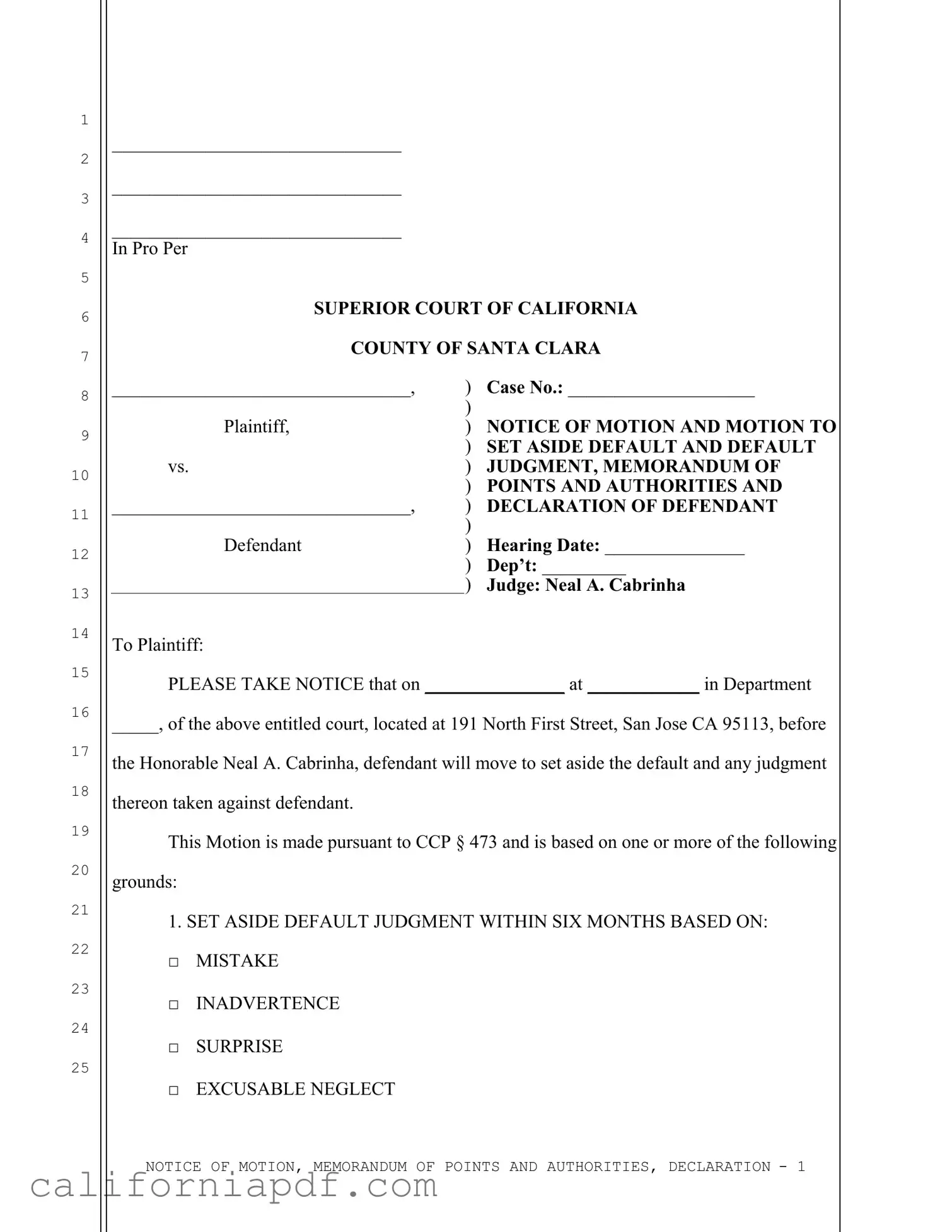The California Motion to Vacate Judgment is closely related to the California Motion Set Aside form. Both documents serve as tools for a defendant to challenge a court's prior judgment or default decision. The Motion to Vacate specifically requests the court to annul or cancel a judgment that has already been entered, on grounds such as mistake, fraud, or new evidence. Similar to the Motion Set Aside, it emphasizes providing a second chance to contest the case’s merits and requires supporting evidence and a legal basis for the request.
Another document that shares similarities with the California Motion Set Aside form is the Motion for Reconsideration. This motion asks the court to review and change its own decision on a motion. While it may focus on decisions other than default judgments, like the Motion Set Aside, it's grounded in presenting new facts, changes in the law, or errors in the court's previous consideration, aiming to alter an unfavorable outcome based on a reevaluation of the case.
The Ex Parte Application for Relief from Default is akin to the California Motion Set Aside form in that both provide a procedural remedy for defendants who have missed critical deadlines, resulting in a default judgment. The Ex Parte Application seeks urgent relief from the court without the usual notice to the other party, emphasizing swift action, typically based on similar grounds like mistake or inadvertence.
The Application to Set Aside Dismissal operates in a similar vein to the California Motion Set Aside form by offering a method for a party to request that the court overturn a dismissal of their case. Dismissal can occur for various reasons, including the failure to prosecute the case or to comply with court orders. Like setting aside a default judgment, setting aside a dismissal allows for the renewal of proceedings and a chance to address the issues anew.
The Notice of Appeal document connects with the California Motion Set Aside form through the pursuit of revisiting a court’s decision. However, instead of asking the original court to reconsider, it announces the intention to take the matter to a higher court. Both documents signal disagreement with a decision and seek a remedy, yet they operate within different contexts and stages of the legal process.
The Petition to Seal Records is related to the Motion Set Aside form more indirectly, focusing on privacy and the protection of personal information after court proceedings. While the Motion Set Aside seeks to challenge and overturn a judgment or default, the Petition to Seal Records aims to restrict access to documents related to that case. Both play crucial roles in impacting the aftermath and perception of a case for a defendant.
The Request for Order document, often used in family law disputes, shares procedural similarities with the Motion Set Aside, as both require the filing of a formal request to the court seeking specific relief. The Request for Order might address issues like child custody, support, or visitation modifications. While the subject matter differs, both processes involve court review and the chance to argue one’s position.
The Writ of Mandamus is a legal document that compels a governmental agency or court to perform a duty they are legally obligated to complete. Although it serves a different function compared to the Motion Set Aside, which deals with internal court decisions rather than external actions, both are mechanisms to challenge or correct actions deemed improper or unlawfully neglected.
Finally, the Answer to Complaint parallels the California Motion Set Aside form in the defensive posture it represents, though at an earlier stage of litigation. While the Answer to Complaint is a defendant’s initial response to the allegations against them, contesting the claims made by the plaintiff, the Motion Set Aside is a remedy for a defendant who failed to make that initial response. Both documents are critical in asserting the defendant’s stance within the legal process.



